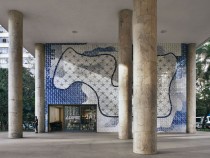
© Leonardo Finotti
The title of a Brazilian textbook on structural engineering for undergraduate students, »Concreto armado: eu te amo« (Reinforced concrete: I love you)1 demonstrates the love affair between this structural element and contemporary architecture in Brazil. Despite the fact that the country is currently the world’s second largest producer of iron ore, metal structures are seldom used in Brazil, where the mining and steel companies and the government are more concerned with exporting than with meeting domestic demand for use in construction. Therefore, taxes, legislation and elevated costs hinder the use of metal components.
On the other hand, the South American giant possesses forests with abundant timber reserves, but, to the great satisfaction of environmentalists, its use in building structures is rare (this, however, does not preclude the use of wood for less noble purposes). There are talented Brazilian professionals who specialise in wood and steel structures, but they remain in the shadows due to the popularity of reinforced concrete. However, the affair between Brazilian architecture and reinforced concrete was not love at first sight: it was a long courtship, more than 30 years in the making, until a spark ignited the relationship between architectural expression and structural tectonics.
It is difficult to rationalise the chemistry behind passion, but there are some factors that help us understand why one was meant for the other. First, in the early twentieth century, the abundance of cheap labor to fashion formwork was accompanied by the burgeoning Brazilian construction industry, contributing to the development of industrialisation within the construction sector. Second, the absence of earthquakes in the Brazil favors the execution of thin concrete components that, with their light appearance, tickle architects’ fancy. (Fernando Serapião)
On the other hand, the South American giant possesses forests with abundant timber reserves, but, to the great satisfaction of environmentalists, its use in building structures is rare (this, however, does not preclude the use of wood for less noble purposes). There are talented Brazilian professionals who specialise in wood and steel structures, but they remain in the shadows due to the popularity of reinforced concrete. However, the affair between Brazilian architecture and reinforced concrete was not love at first sight: it was a long courtship, more than 30 years in the making, until a spark ignited the relationship between architectural expression and structural tectonics.
It is difficult to rationalise the chemistry behind passion, but there are some factors that help us understand why one was meant for the other. First, in the early twentieth century, the abundance of cheap labor to fashion formwork was accompanied by the burgeoning Brazilian construction industry, contributing to the development of industrialisation within the construction sector. Second, the absence of earthquakes in the Brazil favors the execution of thin concrete components that, with their light appearance, tickle architects’ fancy. (Fernando Serapião)













